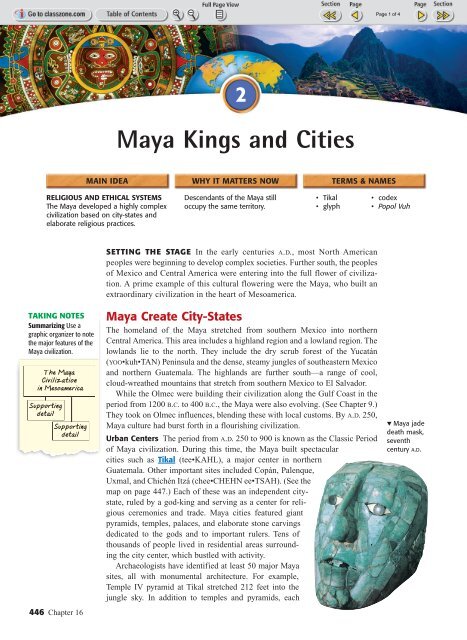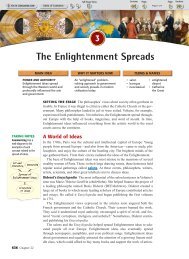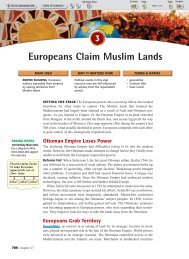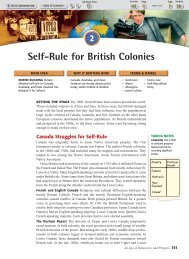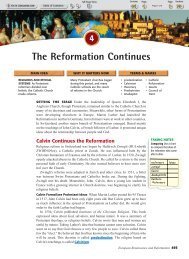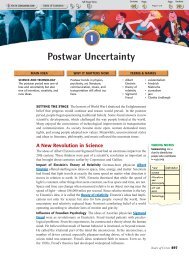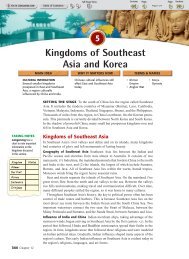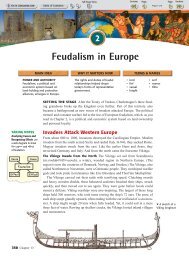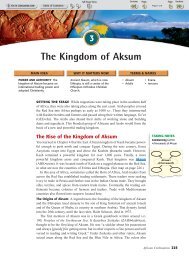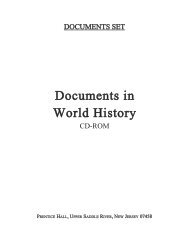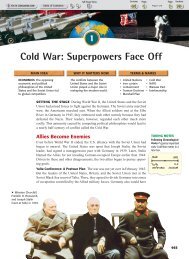Ch 16 Sec 2
Ch 16 Sec 2
Ch 16 Sec 2
- No tags were found...
Create successful ePaper yourself
Turn your PDF publications into a flip-book with our unique Google optimized e-Paper software.
Maya Kings and Cities2MAIN IDEA WHY IT MATTERS NOW TERMS & NAMESRELIGIOUS AND ETHICAL SYSTEMSThe Maya developed a highly complexcivilization based on city-states andelaborate religious practices.Descendants of the Maya stilloccupy the same territory.• Tikal• glyph• codex• Popol VuhTAKING NOTESSummarizing Use agraphic organizer to notethe major features of theMaya civilization.The MayaCivilizationin MesoamericaSupportingdetailSupportingdetail446 <strong>Ch</strong>apter <strong>16</strong>SETTING THE STAGE In the early centuries A.D., most North Americanpeoples were beginning to develop complex societies. Further south, the peoplesof Mexico and Central America were entering into the full flower of civilization.A prime example of this cultural flowering were the Maya, who built anextraordinary civilization in the heart of Mesoamerica.Maya Create City-StatesThe homeland of the Maya stretched from southern Mexico into northernCentral America. This area includes a highland region and a lowland region. Thelowlands lie to the north. They include the dry scrub forest of the Yucatán(YOO•kuh•TAN) Peninsula and the dense, steamy jungles of southeastern Mexicoand northern Guatemala. The highlands are further south—a range of cool,cloud-wreathed mountains that stretch from southern Mexico to El Salvador.While the Olmec were building their civilization along the Gulf Coast in theperiod from 1200 B.C. to 400 B.C., the Maya were also evolving. (See <strong>Ch</strong>apter 9.)They took on Olmec influences, blending these with local customs. By A.D. 250,Maya culture had burst forth in a flourishing civilization.Urban Centers The period from A.D. 250 to 900 is known as the Classic Periodof Maya civilization. During this time, the Maya built spectacularcities such as Tikal (tee•KAHL), a major center in northernGuatemala. Other important sites included Copán, Palenque,Uxmal, and <strong>Ch</strong>ichén Itzá (chee•CHEHN ee•TSAH). (See themap on page 447.) Each of these was an independent citystate,ruled by a god-king and serving as a center for religiousceremonies and trade. Maya cities featured giantpyramids, temples, palaces, and elaborate stone carvingsdedicated to the gods and to important rulers. Tens ofthousands of people lived in residential areas surroundingthe city center, which bustled with activity.Archaeologists have identified at least 50 major Mayasites, all with monumental architecture. For example,Temple IV pyramid at Tikal stretched 212 feet into thejungle sky. In addition to temples and pyramids, each▼ Maya jadedeath mask,seventhcentury A.D.
90°WDrawingConclusionsWhat does theability to constructcomplex buildingsreveal about asociety?Maya city featured a ball court. In thisstone-sided playing field, the Mayaplayed a game that had religious andpolitical significance. The Maya believedthe playing of this game would maintainthe cycles of the sun and moon and bringlife-giving rains.Agriculture and Trade Support CitiesAlthough the Maya city-states wereindependent of each other, they werelinked through alliances and trade.Cities exchanged their local productssuch as salt, flint, feathers, shells, andhoney. They also traded craft goods likecotton textiles and jade ornaments.While the Maya did not have a uniformcurrency, cacao (chocolate) beans sometimesserved as one.As in the rest of Mesoamerica, agriculture—particularlythe growing ofmaize, beans, and squash—provided thebasis for Maya life. For years, expertsassumed that the Maya practiced slashand-burnagriculture. This methodinvolves farmers clearing the land byburning existing vegetation and plantingTropic of CancerLakeTexcocoTulaTlacopanTenochtitlánTeotihuacánValley ofMexicoGulf ofMexicoPACIFICOCEANcrops in the ashes. Evidence now shows, however, that the Maya also developedmore sophisticated methods, including planting on raised beds above swamps andon hillside terraces.Kingdoms Built on Dynasties Successful farming methods led to the accumulationof wealth and the development of social classes. The noble class, whichincluded priests and the leading warriors, occupied the top rung of Maya society.Below them came merchants and those with specialized knowledge, such as skilledartisans. Finally, at the bottom, came the peasant majority.The Maya king sat at the top of this class structure. He was regarded as a holyfigure, and his position was hereditary. When he died, he passed the throne on tohis eldest son. Other sons of the ruler might expect to join the priesthood.00100°W250 Miles500 KilometersMesoamerican Civilizations,200 B.C.–A.D. 1521Teotihuacán Civilization, 200 B.C.–A.D. 700Maya Civilization, 200 B.C.–A.D. 900Toltec Civilization, A.D. 900–1100Aztec Civilization, A.D. 1400–1521Palenque20°NPiedrasNegasUxmal <strong>Ch</strong>ichénIztáYucatánPeninsulaTikalCopánGEOGRAPHY SKILLBUILDER: Interpreting Maps1. Region Which civilization occupied the Yucatán Peninsula?2. Region What other civilization areas were eventuallyincorporated into the Aztec area?10°NReligion Shapes Maya LifeReligion influenced most aspects of Maya life. The Maya believed in many gods.There were gods of corn, of death, of rain, and of war. Gods could be good or evil,and sometimes both. Gods also were associated with the four directions and with differentcolors: white for north, black for west, yellow for south, red for east, and greenin the center. The Maya believed that each day was a living god whose behavior couldbe predicted with the help of a system of calendars.Religious Practices The Maya worshiped their gods in various ways. They prayedand made offerings of food, flowers, and incense. They also pierced and cut theirbodies and offered their blood, believing that this would nourish the gods.Sometimes the Maya even carried out human sacrifice, usually of captured enemies.At <strong>Ch</strong>ichén Itzá, they threw captives into a deep sinkhole lake, called acenote (say•NO•tay), along with gold, jade, and other offerings. The Maya believedPeople and Empires in the Americas 447
that human sacrifice pleased the gods and kept the world in balance.Nevertheless, the Maya’s use of sacrifice never reached the extremes of some otherMesoamerican peoples.Math and Religion Maya religious beliefs also led to the development of thecalendar, mathematics, and astronomy. The Maya believed that time was a burdencarried on the back of a god. At the end of a day, month, or year, one god wouldlay the burden down and another would pick it up. A day would be lucky orunlucky, depending on the nature of the god. So, it was very important to have anaccurate calendar to know which god was in charge of the day.The Maya developed a 260-day religious calendar, which consisted of thirteen20-day months. A second 365-day solar calendar consisted of eighteen 20-daymonths, with a separate period of 5 days at the end. The two calendars were linkedtogether like meshed gears so that any given day could be identified in both cycles.The calendar helped identify the best times to plant crops, attack enemies, andcrown new rulers.The Maya based their calendar on careful observation of the planets, sun, andmoon. Highly skilled Maya astronomers and mathematicians calculated the solaryear at 365.2420 days. This is only .0002 of a day short of the figure generallyaccepted today! The Maya astronomers were able to attain such great precision byusing a math system that included the concept of zero. The Maya used a shell symbolfor zero, dots for the numbers one to four, and a bar for five. The Maya numbersystem was a base-20 system. They used the numerical system primarily forcalendar and astronomical work.Written Language Preserves History The Maya also developed the mostadvanced writing system in the ancient Americas. Maya writing consisted of about800 hieroglyphic symbols, or glyphs (glihfs). Some of these glyphs stood forwhole words, while others represented syllables. The Maya used their writing systemto record important historical events, carving their glyphs in stone or recordingthem in a bark-paper book known as a codex (KOH•DEHKS). Only three ofthese ancient books have survived.Other original books telling of Maya history and customs do exist, however.Maya peoples wrote these down after the arrival of the Spanish. The most famousof these books, the Popol Vuh (POH•pohl VOO), recounts the Highland Maya’sversion of the story of creation. “Before the world was created, Calm and Silencewere the great kings that ruled,” reads the first sentence in the book. “Nothingexisted, there was nothing.”MakingInferencesHow are math,astronomy, and calendarsrelated?▼ A detail fromthe Maya CodexTroanoPRIMARY SOURCEThen let the emptiness fill! theysaid. Let the water weave itsway downward so the earth canshow its face! Let the light breakon the ridges, let the sky fill upwith the yellow light of dawn!Let our glory be a man walkingon a path through the trees!“Earth!” the Creators called. Theycalled only once, and it wasthere, from a mist, from a cloudof dust, the mountains appearedinstantly.From the Popol Vuh448 <strong>Ch</strong>apter <strong>16</strong>
Traits ofCivilizationRise and Fall of the MayaStrength Leadingto PowerWeakness Leadingto Decline• Religious beliefs andtheocracy• Independent city-states• Intensive agriculture• United culture• Loyalty to the king•Wealthy and prosperousculture•Production of more foodfeeds a larger population•Many physical and humanresources funneled intoreligious activities•Frequent warfare occursbetween kingdoms•Population growth createsneed for more landAnalyzing CausesWhy did theMaya civilization gointo decline?SECTION2SKILLBUILDER: Interpreting <strong>Ch</strong>arts1. Recognizing Effects Which trait aids in building a sense of loyalty to the ruler?2. Drawing Conclusions How can intensive agriculture be both a strength and a weakness?Mysterious Maya DeclineThe remarkable history of the Maya ended in mystery. In the late 800s, the Mayasuddenly abandoned many of their cities. Invaders from the north, the Toltec,moved into the lands occupied by the Maya. These warlike peoples from centralMexico changed the culture. The high civilization of Maya cities like Tikal andCopán disappeared.No one knows exactly why this happened, though experts offer several overlappingtheories. By the 700s, warfare had broken out among the various Maya citystates.Increased warfare disrupted trade and produced economic hardship. Inaddition, population growth and over-farming may have damaged the environment,and this led to food shortages, famine, and disease. By the time the Spanish arrivedin the early 1500s, the Maya were divided into small, weak city-states that gave littlehint of their former glory.As the Maya civilization faded, other peoples of Mesoamerica were growing instrength and sophistication. Like the Maya, these peoples would trace some of theirancestry to the Olmec. Eventually, these people would dominate the Valley ofMexico and lands beyond it, as you will learn in <strong>Sec</strong>tion 3.ASSESSMENTTERMS & NAMES 1. For each term or name, write a sentence explaining its significance.• Tikal • glyph • codex • Popol VuhUSING YOUR NOTES2. How do the characteristics ofMaya civilization compare withthe characteristics of a typicalcivilization?The MayaCivilizationin MesoamericaSupportingdetailSupportingdetailMAIN IDEAS3. What was the basis of Mayalife?4. Why was the calendarimportant for the Mayareligion?5. What three explanations havebeen given for the collapse ofthe Maya civilization?CRITICAL THINKING & WRITING6. RECOGNIZING EFFECTS Why was trade important to theMaya civilization?7. DRAWING CONCLUSIONS How important do you thinkthe development of advanced mathematics was in thecreation of the Maya calendar?8. ANALYZING CAUSES Which of the causes for the fall ofthe Maya do you think was most important? Explain.9. WRITING ACTIVITY RELIGIOUS AND ETHICAL SYSTEMSImagine that you are a reporter visiting Maya city-states.Write a one-page news article that describes variousaspects of the Maya religion.CONNECT TO TODAY CREATING A MAPConduct research to discover the countries in which the modern Maya live. Use your findingsto create a map showing the areas within these countries occupied by the Maya.People and Empires in the Americas 449


